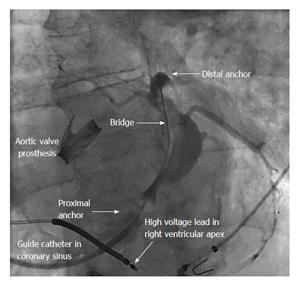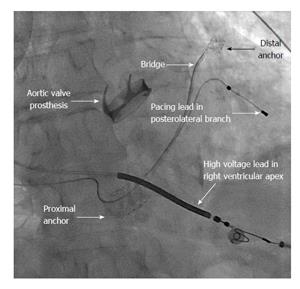Published online May 16, 2016. doi: 10.12998/wjcc.v4.i5.127
Peer-review started: January 20, 2016
First decision: February 2, 2016
Revised: February 14, 2016
Accepted: March 22, 2016
Article in press: March 23, 2016
Published online: May 16, 2016
Processing time: 93 Days and 22.2 Hours
Percutaneous approaches to reduce mitral regurgitation in ischemic cardiomyopathy have stirred interest recently. Patients with ischemic cardiomyopathy and functional mitral regurgitation often meet criteria for cardiac resynchronisation therapy to improve left ventricular function as well as mitral regurgitation, and alleviate symptoms. This case shows that implantation of a pacing lead in the coronary sinus to restore synchronous left and right ventricular contraction is feasible, despite the presence of a remodeling device in the coronary sinus.
Core tip: A review of cardiac resynchronisation therapy in a patient with ischemic cardiomyopathy and previous percutaneous mitral annuloplasty using a remodeling device in the coronary sinus.
- Citation: Swampillai J. Cardiac resynchronisation therapy after percutaneous mitral annuloplasty. World J Clin Cases 2016; 4(5): 127-129
- URL: https://www.wjgnet.com/2307-8960/full/v4/i5/127.htm
- DOI: https://dx.doi.org/10.12998/wjcc.v4.i5.127
This case reports a successful upgrade of an implantable cardioverter defibrillator (ICD) to a biventricular ICD, despite the presence of a remodeling device in the coronary sinus.
A 76-year-old man underwent mechanical aortic valve replacement 23 years ago and developed an ischemic cardiomyopathy [left ventricular (LV) internal diastolic dimension 69 mm, ejection fraction (EF) 30%] with coronary artery disease not amenable to revascularisation. Percutaneous mitral valve annuloplasty had been performed 7 years ago for severe functional mitral regurgitation, using a coronary sinus device (MONARC, Edwards Lifesciences, California). One year after mitral annuloplasty he was in persistent atrial fibrillation with a slow ventricular response rate, and as his LV function remained poor a single chamber ICD was implanted as primary prevention (Virtuoso generator with 6947 Sprint Quattro Secure lead, Medtronic, Minnesota). At generator replacement 6 years later he was in New York Heart Association (NYHA) class 3, with a paced left bundle branch block morphology, QRS duration 130 ms and his EF had deteriorated to 20%. Upgrade to a biventricular ICD was recommended in order to improve LV function, mitral regurgitation and symptoms.
After left subclavian vein access was achieved we advanced a guiding catheter over a wire and into the right atrium. We manipulated a polymer-tip wire past the proximal anchor of the annuloplasty device and into the body of the coronary sinus, and advanced the guide catheter over it. A balloon occlusion venogram was performed (Figure 1) and an 88 cm 5F Medtronic Attain Ability 4296 LV pacing lead was positioned in the posterolateral vein (Figure 2). Electrical parameters were good (threshold 1.0 V at 0.4 ms, R wave 11 mV, impedance 900 ohms) with no diaphragmatic pacing. The guiding catheter was slit and removed without dislodgement, and the lead was sutured to the pectoral muscle fascia. The existing generator was removed and a Medtronic Viva S cardiac resynchronization therapy device was connected to the leads, placed in the subcutaneous pocket, and the wound was closed. At 3 mo post-procedure the patient had symptomatically improved to NYHA class 2, with a mild improvement in LV function and mitral regurgitation on echocardiography.
Implantation of a pacing lead into the coronary sinus is potentially challenging with an annuloplasty device already in the venous system. The device consists of a distal anchor in the great cardiac vein, a flexible shortening bridge, and a proximal anchor in the proximal coronary sinus[1]. The anchors draw the proximal coronary sinus and distal great cardiac vein together, displacing the posterior annulus anteriorly, reducing mitral annulus diameter and septal-lateral distance, and thereby improving mitral insufficiency[2-4]. As left ventricular systolic dysfunction and conduction abnormalities often coexist in patients with valvular heart disease, biventricular pacing is often indicated to attempt to restore synchronous contraction and improve ventricular function. This case shows that cardiac resynchronisation therapy is possible in the presence of a mitral annular remodeling device in the coronary sinus.
Left ventricular systolic dysfunction and conduction abnormalities often coexist in patients with valvular heart disease, biventricular pacing is often indicated to attempt to restore synchronous contraction and improve ventricular function.
This case shows that cardiac resynchronisation therapy is possible in the presence of a mitral annular remodeling device in the coronary sinus.
The paper is well written.
P- Reviewer: Amiya E, Kataoka H, Kettering K, Peteiro J, Ueda H S- Editor: Qiu S L- Editor: A E- Editor: Liu SQ
| 1. | Webb JG, Harnek J, Munt BI, Kimblad PO, Chandavimol M, Thompson CR, Mayo JR, Solem JO. Percutaneous transvenous mitral annuloplasty: initial human experience with device implantation in the coronary sinus. Circulation. 2006;113:851-855. [RCA] [PubMed] [DOI] [Full Text] [Cited by in Crossref: 188] [Cited by in RCA: 170] [Article Influence: 8.9] [Reference Citation Analysis (0)] |
| 2. | Piazza N, Bonan R. Transcatheter mitral valve repair for functional mitral regurgitation: coronary sinus approach. J Interv Cardiol. 2007;20:495-508. [RCA] [PubMed] [DOI] [Full Text] [Cited by in RCA: 1] [Reference Citation Analysis (0)] |
| 3. | Machaalany J, Bilodeau L, Hoffmann R, Sack S, Sievert H, Kautzner J, Hehrlein C, Serruys P, Sénéchal M, Douglas P, Bertrand OF. Treatment of functional mitral valve regurgitation with the permanent percutaneous transvenous mitral annuloplasty system: results of the multicenter international Percutaneous Transvenous Mitral Annuloplasty System to Reduce Mitral Valve Regurgitation in Patients with Heart Failure trial. Am Heart J. 2013;165:761-769. [RCA] [PubMed] [DOI] [Full Text] [Cited by in Crossref: 29] [Cited by in RCA: 24] [Article Influence: 2.0] [Reference Citation Analysis (0)] |
| 4. | Harnek J, Webb JG, Kuck KH, Tschope C, Vahanian A, Buller CE, James SK, Tiefenbacher CP, Stone GW. Transcatheter implantation of the MONARC coronary sinus device for mitral regurgitation: 1-year results from the EVOLUTION phase I study (Clinical Evaluation of the Edwards Lifesciences Percutaneous Mitral Annuloplasty System for the Treatment of Mitral Regurgitation). JACC Cardiovasc Interv. 2011;4:115-122. [RCA] [PubMed] [DOI] [Full Text] [Cited by in Crossref: 98] [Cited by in RCA: 80] [Article Influence: 5.7] [Reference Citation Analysis (0)] |










